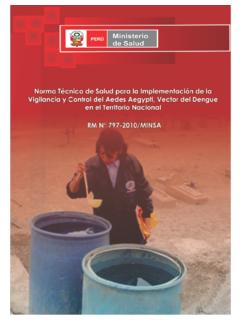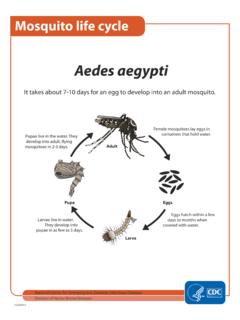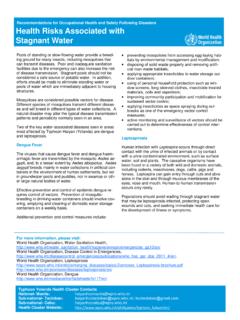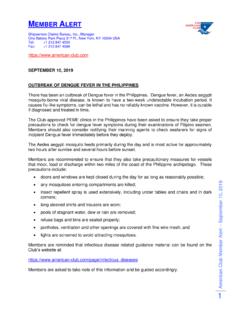Transcription of Current Canine Guidelines for the Prevention, Diagnosis ...
1 Current Canine Guidelines for the Prevention, Diagnosis , and Management of Heartworm (Dirofilaria immitis). Infection in Dogs Revised 2018. Thank You to Our Generous Sponsors: 2018 American Heartworm Society | PO Box 8266 | Wilmington, DE 19803-8266 | E-mail: Current Canine Guidelines for the Prevention, Diagnosis , and Management of Heartworm (Dirofilaria immitis). Infection in Dogs (Revised 2018). CONTENTS. Click on the links below to navigate to each section. Key Points Minimizing Heartworm Transmission in Relocated Dogs (box). Figure 1. Urban heat island profile. BIOLOGY AND LIFE Key Points Figure 2. The heartworm life cycle. Figure 3. Images of a feeding mosquito. HEARTWORM Key Points Macrocyclic Lactones Reports of Lack of Efficacy Vector Control Measures to Reduce Heartworm Transmission (box). Use of Repellents and Ectoparasiticides Multimodal Risk Management PRIMARY DIAGNOSTIC Key Points Test Timing for Optimal Results Microfilaria and Antigen Testing Antigen Tests When Should Heat Treatment of Samples Be Considered?
2 (box). Microfilaria Tests How to Perform the Knott Test (box). Testing Considerations Following Noncompliance and When Changing Products Figure 4. Acanthocheilonema reconditum and Dirofilaria immitis. Figure 5. The testing protocol following known noncompliance. 2018 Canine Heartworm Guidelines 1. Other Diagnostic Aids ..17. Radiography Echocardiography Figure 6. Moderate heartworm disease (radiographs). Figure 7. Severe heartworm disease (radiographs). Figure 8. Echocardiogram. Diagnostics For Pre-Adulticide Evaluation In An Infected PRINCIPLES OF Key Points Table 1. Summary of Clinical Signs of Canine Heartworm Disease Figure 9. Image of the main trunk of the right pulmonary artery. Figure 10. Image of a dead adult heartworm lodged in a distal pulmonary artery. Adulticide Melarsomine Dihydrochloride Pulmonary Thromboembolism Adjunct Steroids NSAIDs and Aspirin Doxycycline Macrocyclic Lactones Macrocyclic Lactones/Doxycycline Figure 11.
3 Pulmonary pathology associated with death of heartworms. AHS-Recommended Table 2. AHS-Recommended Protocol Elimination of Surgical Extraction of Adult Caval Syndrome (Dirofilarial Hemoglobinuria). Pulmonary Arterial Infections Figure 12. Photographic Image of a heart from a dog suffering from caval syndrome. Figure 13. Echocardiogram image. Figure 14. Surgical removal of worms. Alternative Long-term Macrocyclic Lactone Administration Herbal Therapies Compounded Confirmation of Adulticide Elective Surgeries in Dogs with 2 American Heartworm Society Prepared by Dr. C. Thomas Nelson, Dr. John W. McCall, Dr. Stephen Jones, and Dr. Andrew HIGHLIGHTS. Moorhead, and approved by the Executive Board of Diagnostics the American Heartworm Society: Officers: Dr. Chris AHS recommends annual antigen and Rehm, President; Dr. Stephen Jones, Past President; microfilaria testing.
4 (As the interpretation Dr. Tony Rumschlag, Vice President; Dr. Bianca of diagnostics has become more complex, Zaffarano, Secretary-Treasurer; Dr. Patricia Payne, please see the Microfilaria and Antigen Editor; Dr. Doug Carithers, Symposium Program Testing section for more complete Chair; Board Members: Dr. Elizabeth Clyde, Dr. Brian information.). DiGangi, Dr. Chris Duke, Dr. Andrew Moorhead, Dr. Charles Thomas Nelson, and Dr. Jennifer Rizzo; and Prevention Ex Officio Members: Dr. Marisa Ames, Symposium AHS recommends year-round Program Co-Chair; Dr. John W. McCall, Associate administration of preventive drugs Editor; Dr. Chris Adolph and Dr. Edward Wakem. approved by the US Food and Drug Administration (FDA) to prevent heartworm References by Christopher Evans, MS, Research infection and enhance compliance, the Professional II, Department of Infectious Diseases, latter being particularly important in College of Veterinary Medicine, University of light of the documented presence of Georgia.
5 Resistant subpopulations. Application Preamble of an Environmental Protection Agency (EPA) registered mosquito repellent/. These recommendations supersede previous ectoparasiticide has been shown to editions and are based on the information increase the overall efficacy of a heartworm presented at the 2016 Triennial Symposium of prevention program in laboratory the American Heartworm Society (AHS), new studies involving known resistant research, and additional clinical experience. The heartworm isolates by providing control recommendations for the prevention, Diagnosis , of the arthropod vector of heartworm. In and management of heartworm infection in cats addition, AHS recommends reduction of are contained in a companion feline document exposure to mosquitoes through standard (available on the AHS website). environmental control of mosquitoes and their breeding environments, and when possible, reducing outdoor exposure during key mosquito feeding periods.
6 Adulticide Therapy AHS recommends use of doxycycline and a macrocyclic lactone prior to the three-dose regimen of melarsomine (one injection of mg/kg body weight followed at least one month later by two injections of the same dose 24 hours apart) for treatment of heartworm disease in both symptomatic and asymptomatic dogs. Any method utilizing only macrocyclic lactones as a slow-kill adulticide is not recommended. 2018 Canine Heartworm Guidelines 3. EPIDEMIOLOGY. Heartworm infection in dogs has been diagnosed around the globe. In the United States, its territories, and protectorates, heartworm is considered at least regionally endemic in each of the contiguous 48 states, Hawaii, Puerto Rico, US Virgin Islands, and Guam (Bowman et al, 2009; Kozek et al, 1995;. Ludlam et al, 1970). Heartworm transmission has not been documented in Alaska; however, there are regions in central Alaska that have mosquito vectors KEY POINTS: and climate conditions to support the transmission EPIDEMIOLOGY of heartworms for brief periods (Darsie and Ward, Heartworm infection has been diagnosed 2005; Slocombe et al, 1995; Terrell, 1998).
7 Thus, in all 50 states and around the globe. the introduction of microfilaremic dogs or wild Environmental and climatic changes, canids could set up a nidus of infection for local both natural and those created by transmission of heartworm in this state (see box on humans, relocation of microfilaremic page 5 for more on the role of transport of infected dogs, and expansion of the territories of dogs). Such relocation of microfilaremic dogs microfilaremic wild canids continue to be and expansion of the territories of microfilaremic important factors contributing to further wild canids in other areas of the United States spread of the parasite. continue to be important factors contributing to further dissemination of the parasite, as the A pivotal prerequisite for heartworm ubiquitous presence of one or more species of transmission is a climate that provides vector-competent mosquitoes makes transmission adequate temperature and humidity to possible wherever a reservoir of infection and support a viable mosquito population, and favorable climatic conditions co-exist.
8 Change in can also sustain sufficient heat to allow any of these factors can have a significant effect on maturation of ingested microfilariae into the transmission potential in a specific geographic infective, third-stage larvae (L3) within the location. intermediate host. The length of the heartworm transmission Environmental and climatic changes, both season in the temperate latitudes also natural and those created by humans, and animal depends on factors such as the influence movement have increased heartworm infection of microclimates, unique biological habits potential. Commercial and residential real estate and adaptations of the mosquito vector, development of non-endemic areas and areas of variations in time of larval development, low incidence has led to the resultant spread and mosquito life expectancy, and temperature increased prevalence of heartworms by altering fluctuations.
9 Drainage of undeveloped land and by providing water sources in new urban home sites. In the Heartworm transmission does decrease western United States, irrigation and planting of in winter months, but the presence trees has expanded the habitat for Aedes sierrensis of microenvironments in urban areas (western treehole mosquito), the primary vector for suggests that the risk of heartworm transmission of heartworms in those states (Scoles transmission never reaches zero. et al, 1993, 1995). Aedes albopictus (Asian tiger mosquito), which was introduced into the Port of Houston in 1985, has now spread northward and eastward, approaching Canada, and isolated populations have been identified in areas in the western states. This urban- dwelling mosquito is able to reproduce in small containers, such as flowerpots (Benedict et al, 2007). 4 American Heartworm Society Figure 1.
10 Urban heat island profile showing the elevation in urban air temperature compared with rural air temperature. (Image courtesy of Heat Island Group, Lawrence Berkeley National Laboratory). Urban sprawl has led to the formation of The length of the heartworm transmission season in heat islands, as buildings and parking lots the temperate latitudes is critically dependent on the retain heat during the day (Figure 1), creating accumulation of sufficient heat to incubate larvae to microenvironments with potential to support the the infective stage in the mosquito (Knight and Lok, development of heartworm larvae in mosquito 1998 ; Lok and Knight, 1998). The peak months for vectors during colder months, thereby lengthening heartworm transmission in the Northern Hemisphere the transmission season (Morch n et al, 2012, are typically July and August.)






